Rosetta arrives
Rosetta has successfully achieved orbit around Comet 67P/C-G and has transmitted its first close up images. More information here and here about the rendezvous and what science the mission scientists plan to do as they orbit the comet.
The image below is looking down and past the comet’s smaller component as it casts a shadow on the neck and the larger component beyond. As with the earlier images, the comet’s pitted and corroded surface, lacking any obvious craters, is reminiscent to me of a pile of dirty snow that has been dissolving away. In fact, when I lived in New York I would see this kind of look every winter. When the city would get a big snowfall snowplows would push it into large mounds on the side of the road. As time passed these piles would get dirty from the city’s soot and grime, and also slowly melt away. After several weeks it would look almost exactly like the surface of Comet 67P/C-G.
The images and data that will come down from Rosetta over the next year and half as it orbits the comet in its journey around the Sun will be most fascinating. Stay tuned!

On Christmas Eve 1968 three Americans became the first humans to visit another world. What they did to celebrate was unexpected and profound, and will be remembered throughout all human history. Genesis: the Story of Apollo 8, Robert Zimmerman's classic history of humanity's first journey to another world, tells that story, and it is now available as both an ebook and an audiobook, both with a foreword by Valerie Anders and a new introduction by Robert Zimmerman.
The print edition can be purchased at Amazon or from any other book seller. If you want an autographed copy the price is $60 for the hardback and $45 for the paperback, plus $8 shipping for each. Go here for purchasing details. The ebook is available everywhere for $5.99 (before discount) at amazon, or direct from my ebook publisher, ebookit. If you buy it from ebookit you don't support the big tech companies and the author gets a bigger cut much sooner.
The audiobook is also available at all these vendors, and is also free with a 30-day trial membership to Audible.
"Not simply about one mission, [Genesis] is also the history of America's quest for the moon... Zimmerman has done a masterful job of tying disparate events together into a solid account of one of America's greatest human triumphs."--San Antonio Express-News


Very cool!
Bob, your description of slowly melting mounds of dirty snow is right on the money – we see this every winter here in the Chicago area as well & this photo does indeed resemble that…
This is going to be really fun to watch . . . :-)
Great series of images of 67p/c-g, when these dirty snowballs evaporate into space, where does this moisture go to, its not like me hooking up a gauge manifold set to a reefer unit and drawing a 400 micron vacuum and pulling the moisture out, it seems in this way that space is static, although I know that it is hardly static.
Robert may have a better answer, but my understanding is that the volatiles from the nucleus disperse into space in the coma and tail as the surface temperature rises when the comet approaches the Sun.
Very cool to see you’re an HVAC tech. I did a stint in trade school after college because when I graduated there were a lot more jobs for techs than engineers. I worked as a tech for five years before I returned to the dark side. My experience as a tech allowed me career opportunities and gave me an understanding of the field I wouldn’t have otherwise had, and I enjoyed the work.
If there’s a cooler mission running, I don’t know it. As t-dub noted, assuming the craft doesn’t malf, this is going to be a lot of fun.
One of the more sublime benefits of humanity’s space exploration effort is that it turns lights in the sky into places we can go.
“Where does the moisture go?” First it forms the coma around the nucleus, which is essentially the nucleus’s thin atmosphere. Then, as the comet drops closer to the sun, the sun’s solar wind pushes against this and actually overrides the nucleus’s very weak gravitational field, pushing these evaporates away from the nucleus to form the comet’s tail.
This is why every comet tail doesn’t trail behind the comet in line with its movement through space but instead always points away from the sun. It is the solar wind that is pushing it deeper into space.
Thank you both for your answers, I was aware that the solar wind is what pushes a comets tail away from the sun, this is actually a great mission and the pics are nothing like I have ever seen before.
30+ years working on refrigerated trucks and trailers, it has paid well, in many ways it has pigeon holed me, but I am working with my hands basically doing 7th grade science all day, the work is varied from rebuilding engines to repairing leaks and everything in between, Thanks Blair!
Bob, good to hear you on Coast to Coast AM again!
Thank you for the kind words, but tell them that! The more they hear from their listeners how much they like hearing from me, the more they will have me on.
Done.